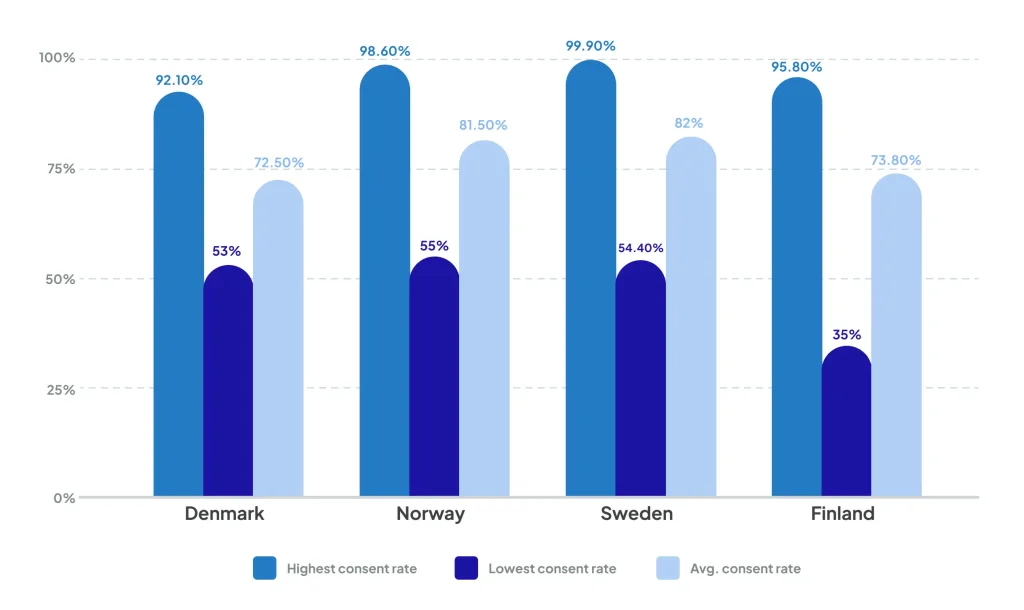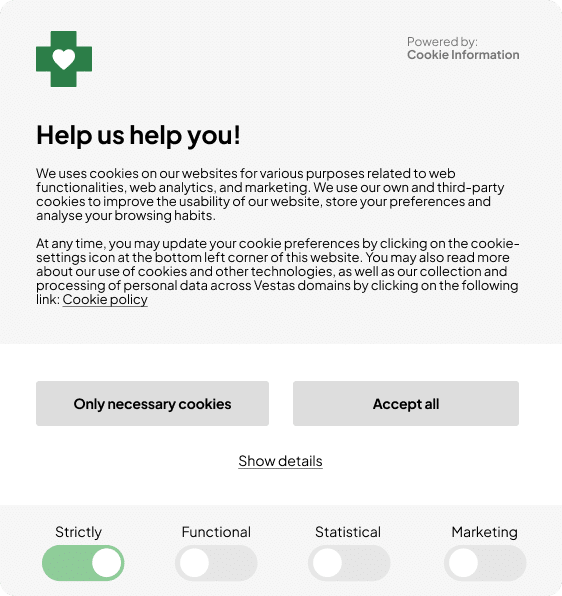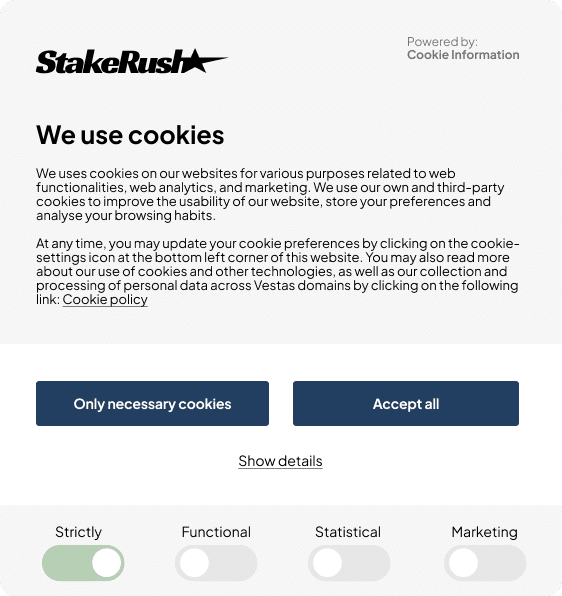Marketers are facing an uphill battle: budgets are shrinking, while expectations are rising.
Amid economic pressures and rising campaign costs, 74% of advertisers are facing budget cuts, according to a report by Accenture. This leaves marketers in a constant struggle to prove their value and the effectiveness of their work.
The solution to these challenges seems to center around one thing: Data.
More specifically, consumer data, because it’s widely accepted as the key to unlocking effective targeting, personalization, and, ultimately, better campaign performance.
But here’s the catch: Collecting this data often hinges on obtaining consumer consent, which is increasingly difficult in a privacy-conscious world dominated by third-party trackers and online identifiers.
As privacy regulations tighten and third-party cookies fall out of favor, marketers must rethink their data strategies, or risk being left behind.
In light of this, our recent study on cookie consent rates across domains in the Nordics sheds light on a critical, yet often overlooked, aspect of data collection:
User trust.
Study: Consent rates across the Nordics
In marketing circles, there’s a lot of talk about how to make data collection less dependent on user consent.
Likewise, we’ve seen an increasing number of tools and methods — such as Consent Mode v2, Enhanced conversions, server-side tracking, and more — that promise greater control over the data collection process, and ways to collect user data even when users reject cookies and tracking.
While these tools offer potential solutions, relying less on consent is not always sustainable.
What if, instead, you tackled the problem at its root?
By increasing your consent rates, you not only stay compliant, but you also ensure more accurate data and better campaign performance in the long term.
For example, imagine increasing your consent rate from 50% to 70%. This 20 percentage-point increase would give you access to more users, allowing for improved A/B testing, more retargeting opportunities, and richer insights into your audience.
Before you start making improvements, let’s first try to benchmark a “good” consent rate. To give you an idea, we’ve analyzed some proprietary data from our recent study on consent rates across the Nordics.
Study overview
Our study analyzed consent rates across Cookie Information clients in four countries:
Denmark, Sweden, Norway, and Finland.
- We examined 500 domains in each country.
- These domains were selected based on the highest number of collected consent preferences during the period from January 1, 2024, to May 15, 2024.
- The selected domains all had compliant cookie banners
Note: “Consent preferences” refers to any user registration of consent preferences, including both those who accepted data collection and those who rejected it. “Consent rate” refers to the number of users who accepted cookies.
Study results
Consent rates
The findings highlighted substantial differences in consent rates between the highest and lowest rates within each country.

As you can see, average consent rates ranged from 72.5% to 82%.
Notably, some countries achieved consent rates above 90%. This demonstrates that it is indeed possible to remain compliant without sacrificing a significant amount of data.
Best practices for banner design and UX
Banner size, placement, design, and other elements can all affect your consent rates. They influence how your users interact with your cookie banner and can either encourage or discourage consent.
Our study identified common traits among the top-performing 10% of domains:
- They use some version of our ‘Overlay’ banner template
- They use two buttons on the banner: ‘Accept’ and ‘Decline’
- They differentiate the colors used on the ‘Accept’ and ‘Decline’ buttons
- They use green for the ‘Accept’ button
These design choices help create a smoother, more user-friendly experience. And there are plenty of other elements you can change which can directly optimize your consent rate. However, compliance and user experience go hand-in-hand. While optimizing your banner, it’s important to avoid “dark patterns” that might mislead users.
Implications
So, should you just follow best practices for banner design and aim for a consent rate between 72.5% and 82%?
While that’s a great starting point, the reality is more complex. Many factors beyond banner design affect your consent rates, including the level of trust your users have in your brand.
Take this example from our study:
- Two domains
- One for a healthcare company; the other for a betting company
- Their cookie banners are functionally identical
Which of the two domains do you think had the highest consent rate?


Surprisingly, it was the betting company.
The betting company had a consent rate of 91.8%; the healthcare company had one of 56.5%.
The point I’m trying to make with this example is two-fold:
Trust is an important (and often overlooked) aspect of consent rates
According to a Cisco survey, 58% of consumers read privacy notices and 53% of consumers actively manage their cookie preferences. This indicates that approximately half of consumers are engaged in managing their online privacy, while the other half are less concerned.
The more privacy-conscious segment of users — who actively engage with privacy settings — will have a significant influence on your overall consent rate. And the willingness to consent to cookies among users in this segment, is likely to come down to how transparent you are and how much they trust your business and data collection practices.
However…
The degree to which trust matters is likely to depend on your business category
At first glance, you might expect the healthcare company to have a higher consent rate, given that healthcare professionals are generally trusted figures of authority. On the other hand, betting companies aren’t typically associated with trust.
So, why does the betting company have a much higher consent rate?
The answer lies in the specific context of your audience.
Healthcare users might be more protective of their sensitive data, even if they trust the institution.
On a betting site, users are often more comfortable sharing data, especially when they perceive it as a necessary trade-off for personalized experiences. This demographic’s relative comfort with data-sharing might explain the higher consent rate, despite the industry’s typically lower trustworthiness.
Experts Opinion
What do you consider the most influential factors affecting consent rates?
I believe the most influential factors that affect consent rate are UX, specifically clarity of language and transparency. A lot of banners are so complex they cause overwhelm and confusion.
What is the single most effective action marketers can take to increase consumer willingness to allow data collection and tracking?
The most influential action that a marketer can take to increase consent rate is to built trust. The best way to build trust with your banner is to be clear, transparent, and not trick your user. Respecting them to make a choice and honour it.
Founder & Data Protection Consultant, Raze
Data collection in a post third-party cookie world
While optimizing cookie banners and understanding user trust are vital, these strategies must be viewed in light of the deprecation of third-party cookies. It’s been an ever-present theme of debate ever since 2020, when Google first announced that they would phase out third-party cookies.
As you’ve probably heard by now, Google ended up postponing the phase-out several times, and ultimately decided not to follow through with their initial plan. Instead, they’ve announced that they’re working on a new experience in Chrome that lets users make an informed choice at the browser level.
While the details remain to be unveiled, this shift may lead to fewer users consenting to cookies, as they could opt out with a single, one-time choice. This could significantly affect consent rates across all industries.
And this could spell trouble for marketing departments that still rely on last-click attribution – which around 65% of marketing departments relied on in 2023 – because it’s highly dependent on third-party cookies. This is also the case for multi-touch attribution, which is generally seen as an improvement on last-click attribution.
This means that marketers will be forced to adjust their approach to tracking, and look for more privacy-friendly alternatives.
What are the alternatives to third-party cookies?
The deprecation of third-party cookies presents a significant challenge, but there are effective alternatives, such as:
First-party data acquisition has gained traction as a response to the deprecation of third-party cookies. However, this doesn’t solve the core problem: You still need users to voluntarily share their data.
As mentioned earlier, tools like Google Consent Mode v2 and its Conversion Modeling feature allow marketers to model user behavior for those who do not consent to cookies. However, this method still relies on the data collected from users who have given their consent.
So, regardless of the tools or strategies you use, gaining user consent remains crucial. This hinges on transparency, the value you offer in return, and the trust users have in your business.
In other words: It’s bound to be a long-term effort.
Building trust for long-term success
In a privacy-centric world, the road to successful data collection is a long-term effort that starts with user trust. Having the right tools in place is the first step toward building trust and staying compliant.
At Cookie Information, we’re here to help you get the basics right.
If you’re looking for a Consent Management Platform that simplifies consent collection for both you and your users, why not give Cookie Information a try?
It’s free for 14 days, so you can see just how easy it is to streamline your consent management.